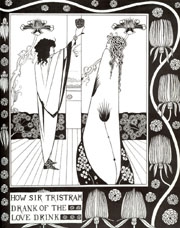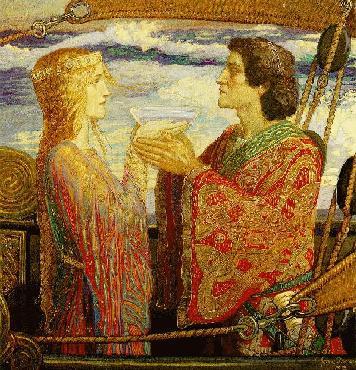
| Spring, 2018 |
 |
Dr. Debora B. Schwartz |
| Class meetings: T/Th 2:10-4:00 PM, Rm. 2-13 | e-mail: dschwart@calpoly.edu | |
| Office: 47-35G, tel. 756-2636 | Main English Office: 756-2597 |
Calendar, Spring, 2018

| Week | 1 | 2 | 3 | 4 | 5 | 6 | 7 | 8 | 9 | 10 |
NOTE: DO NOT PRINT OUT THIS CALENDAR OF
ASSIGNMENTS!! Consult it online, as assignments
are subject to change.
Note 1: some required readings are accessed
electronically. Electronically accessed readings may
be in one of the following forms:
Note 2: Occasionally, a link on the course calendar leads to an online study guide for an individual text. Be sure to PRINT OUT study guides and read them BEFORE you begin the primary reading assignment. Keep them in your course binder (which you should always bring with you to class).
|
|
|
| Day 1 |
Introduction and background; course
requirements and expectations.
|
| Day 2 |
TOPIC: The Baseline
Story: Joseph Bédier's Modern Retelling, The
Romance of Tristan and Iseult
REQUIRED BACKGROUND READING: REQUIRED PRIMARY READING: TEXT INFO: Joseph Bédier based this modern French retelling of the Tristan stories (1900) on extensive comparison of the extant medieval source material; he sought in this way to recreate the lost "original" text (but in fact created a distinctly 20th-century narrative). Translated into modern English by Hilaire Belloc and Paul Rosenfeld. (Please note that you are responsible for all information listed as "TEXT INFO" or "FILM INFO" on the course calendar for your reading quizzes and exams!) |
|
|
|
| Day 1 |
TOPIC: An episodic romance: Béroul, The
Romance of Tristan.
REQUIRED BACKGROUND READING:
--Note 1: Be aware that the passages printed in italics are not part of Béroul's poem -- they are additions taken from Bédier's reconstruction of the "whole" story and inserted by the translator to smooth out the choppiness of the incomplete narrative preserved in the single extant manuscript of Béroul's romance. You should skim these italicized passages. --Note 2: the episode of "Tristan's Madness" printed pp. 151-164 of the Béroul textbook is likewise not part of Béroul's text; it is an entirely separate episodic poem (assigned for our next class meeting) which the translator chose to incorporate into the Penguin Classics translation of Béroul because of its clear connection to Béroul's narrative. TEXT INFO: Béroul wrote his romance, in French octosyllabic rhyming couplets, some time in the second half of the twelfth century; it appears to have influenced the work of Chrétien de Troyes (active ca. 1170-1190), so we assume it to predate those of Chrétien's works which show its influence. Preserved in only one manuscript, in a single fragment of 4,485 lines; this fragment is itself divided into various episodes. Part of the so-called "common tradition." |
| Day 2 |
As needed: complete
discussion of Béroul.
NEW TOPIC: Competing Versions and Medieval Fragments (Marie de France, "Chevrefoil"; fragments of Thomas's Romance of Tristan; the independent episode of Tristan's Madness) REQUIRED BACKGROUND READING:M REQUIRED PRIMARY READING: TEXT INFO:
|
|
|
|
| Day 1 | TOPIC: An anti-Tristan: Chrétien de Troyes's Cligés
REQUIRED BACKGROUND READING: REQUIRED PRIMARY READING: TEXT INFO: Chrétien de Troyes was active ca. 1170-1190; Cligés, his second extant romance, is in French octosyllabic rhyming couplets. Optional: follow link for information on Chrétien de Troyes's The Knight of the Cart, the first Lancelot and Guenevere romance, which was also modelled on the Tristan romances, from which it borrows freely (includes e.g. variations on the flour on the floor episode, the ambiguous oath, a passion inspired by a woman's golden hair, and an adulterous passion linking a King's wife with his best knight). |
| Day 2 | FIRST HOUR OR AS
NEEDED: Complete discussion of Cligés NEW TOPIC: Tristan Film 1 -- Tom Donovan's Lovespell (filmed 1979; released 1981) REQUIRED BACKGROUND READING: You must have screened the Donovan film and FILLED OUT THE REQUIRED VIDEO WORKSHEET (available on Polylearn) and POSTED IT to your PolyLearn Discussion Group BEFORE this class meeting. There will not be an in-class screening; instead, there will be an in-class discussion of the film (during which some clips may be shown). Bring a hard copy of your Video Worksheet with you to the class meeting so that you can add to your notes during the video discussion. REQUIRED FILM:
|
| Topic and Readings | |
| Day 1 |
TOPIC: A Mega-Romance: Gottfried von Strassburg's Tristan REQUIRED BACKGROUND READING: REQUIRED PRIMARY READING: TEXT INFO: written ca. 1210, Gottfried's Tristan, a German romance that is an adaptation or translatio (more than simply a "translation") of Thomas's romance, contains 19,416 lines in rhyming couplets; it breaks off (presumably because Gottfried died before finishing it) just after the point where the surviving fragments of Thomas begin. Part of the so-called "courtly tradition." |
| Day 2 | TOPIC:
Gottfried von Strassburg's Tristan, concl.
REQUIRED PRIMARY READING:
|
| Topic and Readings | |
| Day 1 | As
needed, complete discussion of Gottfried von
Strassburg's Tristan
NEW TOPIC: Wagner's Opera Tristan und Isolde REQUIRED BACKGROUND READING: Also recommended: REQUIRED FILM: OPERA AND FILM INFO: Richard Wagner's opera Tristan und Isolde, composed 1857-59, was based on Gottfried's Tristan. The video of "Extended Scenes" (musical highlights linked by narration) presents excerpts from the 1976 Opéra du Québec production starring Jon Vickers as Tristan and Roberta Knie as Isolde, with the Montreal Symphony Orchestra, under the baton of conductor Franz-Paul Decker. NOTE: Click on link to read the Synopsis of the opera BEFORE viewing the video (approx. 90 min.). |
| Day 2 | As needed: Wrap-up Discussion
of Wagner and Gottfried; Exam Essay Workshop.
REQUIRED READINGS:
|
| Topic and Readings | |
| Day 1 | MIDTERM EXAM |
| Day 2 | TOPIC: The Victorian Era 1 -- Matthew
Arnold's Tristram and Iseult
REQUIRED BACKGROUND READING: Also recommended (but NOT required): REQUIRED PRIMARY READING: TEXT INFO: British poet Matthew Arnold lived from 1822-1888. His "Tristram and Iseult" (1852), the first ninetheenth-century English treatment of the theme, is a narrative poem comprising a series of monologues and dialogues written in various forms of rhymed verse (primarily but not exclusively in couplets). |
| Topic and Readings | |
| Day 1 | As needed, continue discussion of
Arnold.
NEW TOPIC: The Victorian Era 2 -- Alfred, Lord Tennyson's "The Last Tournament" REQUIRED BACKGROUND READING: Also recommended (but NOT required):
|
| Day 2 | As
needed, continue discussion of Tennyson.
NEW TOPIC: The Victorians and Pre-Raphaelitism -- Algernon Charles Swinburne REQUIRED BACKGROUND READING: REQUIRED PRIMARY READINGS: Be sure to PRINT OUT readings, place them in your course binder, and BRING THEM WITH YOU TO CLASS. Also highly recommended:
|
| Topic and Readings | |
| Day 1 |
Complete discussion of Algernon Charles Swinburne REQUIRED BACKGROUND READING: REQUIRED PRIMARY READINGS: Be sure to PRINT OUT readings, place them in your course binder, and BRING THEM WITH YOU TO CLASS. Also highly recommended:
|
| Day 2 |
NEW TOPIC: Late 19th-20th-Century Perspectives -- Reimagining Isolde of the White Hands REQUIRED BACKGROUND READING:
-- NOTE: On your print-out of the Adams poem, you will need to WRITE IN LINE NUMBERS for every 5th line. For your numbering, count "Isolt the White, the daughter of a king," as line 1; thus, line 5 (the first you should number) is "Upon an autumn midnight drencht with rain."TEXT AND AUTHOR INFO:
|
| Topic and Readings | |
| Day 1 | TOPIC: Contemporary
American Fiction -- Steven Millhauser's The King in
the Tree
REQUIRED BACKGROUND READING:
VHS copies of both films are on reserve at the Kennedy Library Circulation Desk under ENGL 380, so you can check them out on your own time for independent in-library viewing -- BUT PLEASE BE SURE THE VIDEO IS RETURNED TO THE CIRCULATION DESK BY 1/2 HOUR BEFORE A SCHEDULED GROUP SCREENING! In the past, a high-quality transfer of The Eternal Return was available on Hulu Plus (follow link to sign up for a free trial membership), but I don't know whether it is currently available there. I have reserved computer labs in the Kennedy Library for screenings of Fire and Sword at the following dates and times:
As usual, whoever arrives first at the library should check out a copy of the film from the course reserve at the circulation desk. |
| Day 2 |
REQUIRED PRIMARY READINGS: TEXT AND AUTHOR INFO:
|
| Topic and Readings | |
| Day 1 | Tristan Film 2 and 3
-- Jean
Delannoy's L'Éternel retour (1943) and
Veith von Fürstenberg's Fire
and Sword (1982)
These films are REQUIRED VIEWING BY TODAY'S CLASS. REQUIRED BACKGROUND READINGS: HIGHLY RECOMMENDED:
NOTE: By our last class meeting, on W 6/4, you will need to have screened Keith Reynolds's Tristan and Isolde (2006, 125 min.). A DVD copy is on reserve for ENGL 380. Because it is widely available (on NetFlix, Amazon.com video-on-demand, and possibly in local libraries and/or video stores, as well as on reserve in the Kennedy Library), unless there is a specific request, no group screenings will be held for this film; see it on your own or with a friend. |
|
|
TOPIC: Tristan Film 4 -- Keith
Reynolds's Tristan
and Isolde (2006)
REQUIRED BACKGROUND READINGS:
|

Return to ENGL 380 Home Page